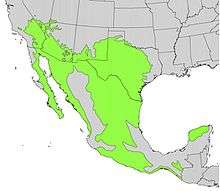Prosopis glandulosa
| Prosopis glandulosa | |
|---|---|
| | |
| Foliage with seedpods | |
| Scientific classification | |
| Kingdom: | Plantae |
| (unranked): | Angiosperms |
| (unranked): | Eudicots |
| (unranked): | Rosids |
| Order: | Fabales |
| Family: | Fabaceae |
| Genus: | Prosopis |
| Species: | P. glandulosa |
| Binomial name | |
| Prosopis glandulosa Torr. | |
| Varieties | |
|
Prosopis glandulosa var. glandulosa | |
 | |
| Natural range | |
| Synonyms | |
|
Prosopis juliflora var. glandulosa (Torr.) | |
Prosopis glandulosa, commonly known as honey mesquite,[2] is a species of small to medium-sized, thorny shrub[3] or tree in the legume family (Fabaceae).
Distribution
The plant is primarily native to the Southwestern United States and Northern Mexico. Its range extends into southern Kansas and eastern Texas, where average annual rainfall is in excess of 40 inches (100 cm).[1]
It can be part of the Mesquite Bosque plant association community in the Sonoran Desert ecoregion of California and Arizona (U.S.), and Sonora state (México).
Description

Prosopis glandulosa has rounded big and floppy, drooping branches with feathery foliage and straight, paired spines on twigs. This tree normally reaches 20–30 ft (6.1–9.1 m), but can grow as tall as 50 ft (15 m). It is considered to have a medium growth rate.
It flowers from March to November, with pale, yellow, elongated spikes and bears straight, yellow seedpods. The seeds are eaten by a variety of animals, such as scaled quail. Other animals, including deer, collared peccaries, coyotes, and jackrabbits, feed on both pods and vegetation.[4]
Varieties
- Prosopis glandulosa var. glandulosa (syn. Prosopis chilensis var. glandulosa (Torr.) Standl., Prosopis juliflora var. glandulosa (Torr.) Cockerell)[5]
- Prosopis glandulosa var. torreyana (L.D.Benson) M.C.Johnst. (syn. Prosopis juliflora var. torreyana L.D.Benson)[6]
Invasive species
Prosopis glandulosa has been intentionally introduced into at least a half-dozen countries. The IUCN considers it as one of the world's 100 worst invasive species outside its native habitat range.[7]
The seeds are disseminated by livestock that graze on the sweet pods, and the shrubs can invaded grasslands, with cattlemen regarding mesquites as range weeds to be eradicated.[8] Due to latent buds underground, only coppicing them makes permanent removal difficult. A single-trunked tree that is cut down will soon be replaced by a multi-trunked version.[9]
Uses
Prosopis glandulosa shrubs and trees provide shelter and nest building material for wildlife, and produce seed pods in abundance containing beans that are a seasonal food for diverse birds and small mammal species.[3] As the common name indicates, honey mesquite is a honey plant that supports native pollinator species of bees and other insects, and cultivated honey bees.[8] It is a larval host for the long-tailed skipper and Reakirt's blue butterflies.
Mesquite flour contains abundant protein and carbohydrates, and can be used in recipes as a substitute for wheat flour.
In Namibia, although an invasive species, it has qualities that have made it useful for humans, including: growing extremely rapidly there, having very dense shade, abundantly producing seed pods, and a readily available firewood.[10]
Indigenous peoples
The indigenous peoples of California and southwestern North America used parts of Prosopis glandulosa as a medicinal plant, food source, building and tools material, and fuel.[11] The Cahuilla ate the blossoms and pods, which were ground into meal for cake.[12][13] The thorns of the plant were used as tattoo needles, and the ashes for tattoos, by the Cahuilla and Serrano Indians of Southern California.[3] The hard wood is prized for making tools and arrow points,[3] and for the unique flavor it lends to foods cooked over it. The deep taproots, often larger than the trunks, are dug up for firewood.
This species of mesquite, known as haas (pronounced [ʔaːs]) by the Seri people of northwestern Mexico, was very important for food and nonfood uses. The Seris had specific names for various stages of the growth of the mesquite pod.[14] Historically, it was a very important wild food plant because it fruits even during drought years.[15]
References
- 1 2 "Taxon: Prosopis glandulosa Torr.". Germplasm Resources Information Network. United States Department of Agriculture. 1997-05-22. Retrieved 2010-01-01.
- ↑ "Prosopis glandulosa". Natural Resources Conservation Service PLANTS Database. USDA. Retrieved 14 October 2015.
- 1 2 3 4 Marsh Trail Guide, Big Morongo Canyon Preserve
- ↑ "Prosopis glandulosa Torr." (PDF). International Institute of Tropical Forestry. United States Forest Service. Retrieved 2009-06-29.
- ↑ "Taxon: Prosopis glandulosa var. torreyana". Germplasm Resources Information Network. United States Department of Agriculture. 1997-05-22. Retrieved 2010-01-01.
- ↑ "Taxon: Prosopis glandulosa var. torreyana (L. D. Benson) M. C. Johnst.". Germplasm Resources Information Network. United States Department of Agriculture. 1997-05-22. Retrieved 2010-01-01.
- ↑ "Prosopis glandulosa (tree)". Global Invasive Species Database. Invasive Species Specialist Group. Retrieved 2008-05-01.
- 1 2 NPIN Database: Prosopis glandulosa
- ↑ Simpson, Benny J. (1988). A Field Guide to Texas Trees. Texas Monthly Press. pp. 244–245. ISBN 0-87719-113-1.
- ↑ Namibia: Invasive Species a Money-Spinner, Africa: Allafrica.com, 2012, retrieved 30 November 2012
- ↑
- ↑ "Cahuilla Plants". enduringknowledgepublications.com. Retrieved 2012. Check date values in:
|access-date=(help) - ↑ "Temalpakh Ethnobotanical Garden". malkimuseum.org. Retrieved 2007. Check date values in:
|access-date=(help) - ↑ Felger, Richard; Mary B. Moser. (1985). People of the desert and sea: ethnobotany of the Seri Indians. Tucson: University of Arizona Press.
- ↑ "Species: Prosopis glandulosa". Fire Effects Information System. United States Forest Service. Retrieved 2008-05-01.
External links
 Data related to Prosopis glandulosa at Wikispecies
Data related to Prosopis glandulosa at Wikispecies- USDA Plants Profile for Prosopis glandulosa (honey mesquite)
- Calflora Database: Prosopis glandulosa (Honey mesquite)
- Jepson Manual eFlora (TJM2) treatment of Prosopis glandulosa
- Lady Bird Johnson Wildflower Center NPIN−Native Plant Information Network: Prosopis glandulosa (Honey mesquite)
- UC CalPhotos gallery
| Wikimedia Commons has media related to Prosopis glandulosa. |
